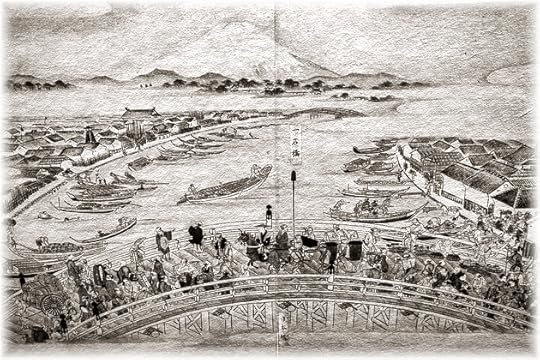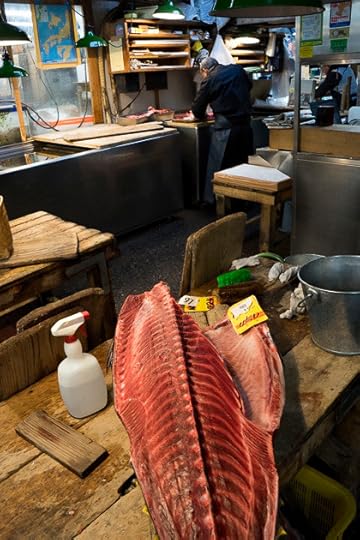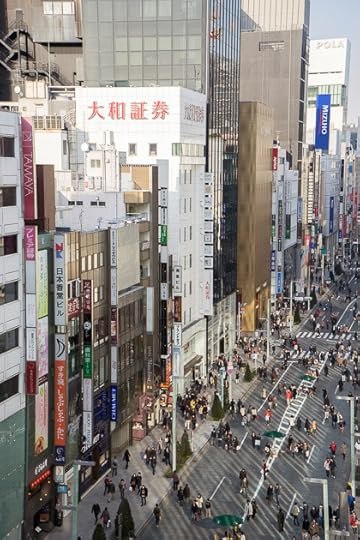Michael Powell's Blog, page 88
March 24, 2014
The Streets of Ryogoku
Home to the Edo-Tokyo Museum and best known as the heart of sumo wrestling, the northeastern neighborhood of Ryogoku conceals a few other worthwhile attractions. Fireworks, sumo food, Ronin, and the most depressing temple imaginable were all part of our day in Ryogoku.

We had seen a bit of Ryogoku after visiting the Edo-Tokyo Museum, and were sufficiently intrigued to return the very next day. Far and away, the neighborhood’s dominant theme is sumo. Besides the massive Sumo Stadium (which we’l...
The Edo-Tokyo Museum
After noticing the gargantuan white hulk of the Edo-Tokyo Museum from atop the SkyTree, we wondered how even the world’s biggest city could possibly justify such a huge history museum. But as we realized after visiting, when the exhibits include full-scale reconstructions of theaters, houses and banks, the extra room comes in handy.

We had recently briefed ourselves on Tokyo’s history, and felt prepared to enter the museum, which is in Ryogoku adjacent to the National Sumo Stadium. The saga of...
March 23, 2014
The Earthquake Memorial Park and Kyu Yasuda Garden
Just before noon on September 1st, 1923, Tokyo was struck by the most devastating earthquake in its history. 70% of the city’s housing was destroyed and over 140,000 people lost their lives during the quake, as well as in the subsequent fires which raged uncontrollably through the streets.

In Yokoami, we visited a memorial park dedicated to the Great Kantō Earthquake of 1923. The location of the park is not an accident: this is the former grounds of an army clothing depot where 38,000 people w...
March 20, 2014
A Concise History of Tokyo

Unlike many of the places we’ve visited, Tokyo doesn’t have a history which streches far into the past. In fact, before the close of the 19th century, Tokyo didn’t even exist; the city was called Edo. But Tokyo’s rapid ascension from village to “World’s Biggest City” has been as catastrophic as it has been meteoric; growing pains are always the most brutal for those who mature too quickly.
3000 BC
The first appearance of humanity in the Kantō Plain.
628 AD
Fishermen brothers discover a Buddhist i...
The Fisher Village of Tsukishima
On the western edge of the man-made island of Tsukishima, we found a small neighborhood ringed in completely by canals. Traditionally home to fishermen, this area feels somehow detached from the rest of Tokyo, with quiet lanes instead of broad boulevards, small two-story houses instead of steel skyscrapers, and an appealing atmosphere of small-town tranquility.

In order to access the fishermen’s quarters of Tsukishima, we had to cross by foot over a small red bridge; a fitting way to enter suc...
March 19, 2014
The Hamarikyu Detached Palace Gardens
A quiet oasis floating atop the murky waters of Tokyo Bay, the Hamarikyu Detached Palace Gardens transport you back to the days of the Shogun… as long as you manage to keep your eyes focused on the duck ponds and cherry trees, instead of the impenetrable row of skyscrapers on the horizon.

In 1654, the swamp which had occupied this space was filled in to create ground for the private residence of the Shogun’s brother, Matsudaira Tsunashige. With its multiple tidal ponds, the land would become t...
The Tsukiji Fish Market
With over 60,000 employees and billions of dollars in yearly commerce, Tokyo’s Tsukiji Wholesale Market is the biggest fish market in the world. The action begins every day at 3am, as shipments of fresh and frozen fish from around the world arrive over land and sea.

Tokyo’s principal market had traditionally been held in the more-central Nihombashi neighborhood, but after the devastating Kantō earthquake of 1923, it was moved to Tsujiki, closer to the port and the railway lines of Shiodome. A...
March 17, 2014
The Tokyo International Forum
Built in 1997 by Argentine-American architect Raphael Viñoly, the Tokyo International Forum is found next to Tokyo Station, in the dead center of the city. The spacious exhibition hall stretches across four buildings connected by a curving glass roof. Steel, glass, sharp angles and plenty of light help make the complex a photographer’s dream.

Jürgen, of course, is a photographer. By now, he and I have been together for so long that it’s no longer a surprise when, after finding a place like the...
March 16, 2014
Shiodome
Shiodome, the onetime railway center of Tokyo, has recently blossomed into one of the city’s most modern neighborhoods. We spent an entertaining morning wandering around its skyscrapers, feeling like ants in the presence of giants.

Just like Ginza, the neighborhood immediately to its north, Shiodome was originally swamp land, filled on the orders of Lord Tokugawa in the early 17th century. In 1872, during the Meiji Era, Shiodome became the Tokyo terminal of Japan’s first railway line. But with...
March 14, 2014
The Ginza Stroll
Ever since springing to life in the 17th century as home to the Edo’s silver-coin mint, the central district of Ginza has been among Tokyo’s most popular places to stroll, shop, see and be seen. We spent our first Saturday in the city walking along the joyfully car-free street of Chuo-Dori, people-watching, and popping into some world-famous stores.

On weekends, traffic on Ginza’s main artery of Chuo-Dori is prohibited, allowing walkers to enjoy what’s become known as the Hokoten, most frequen...



